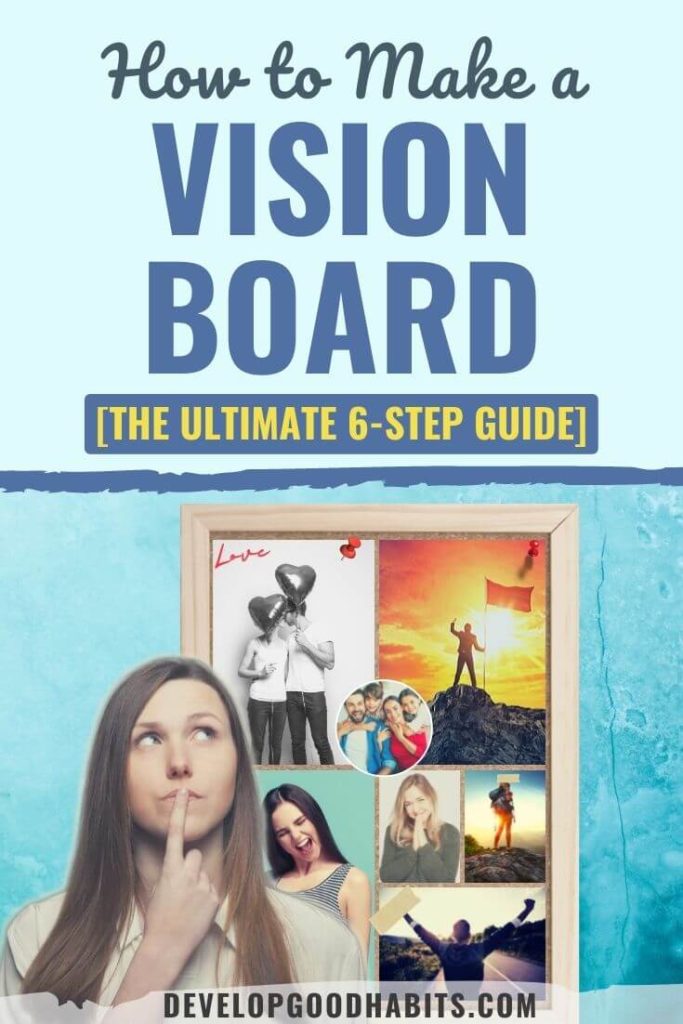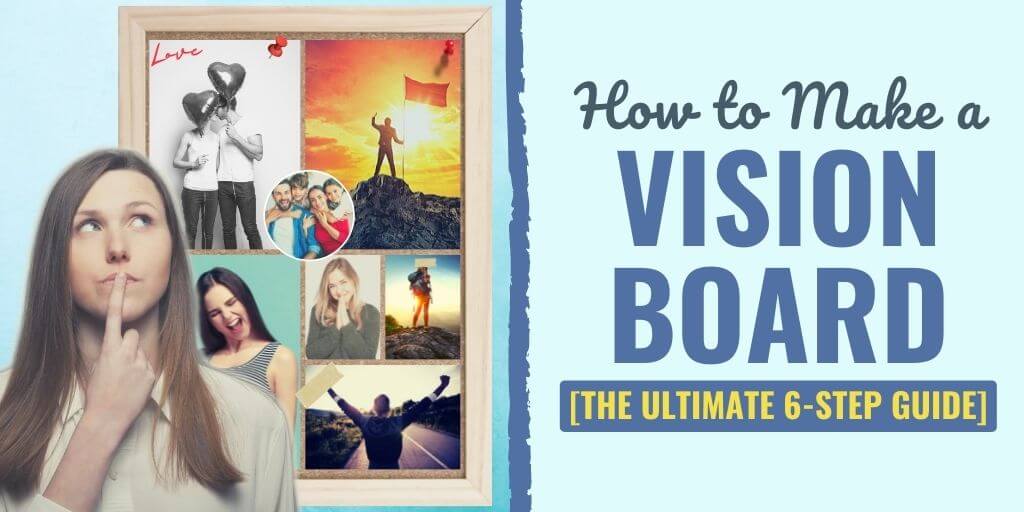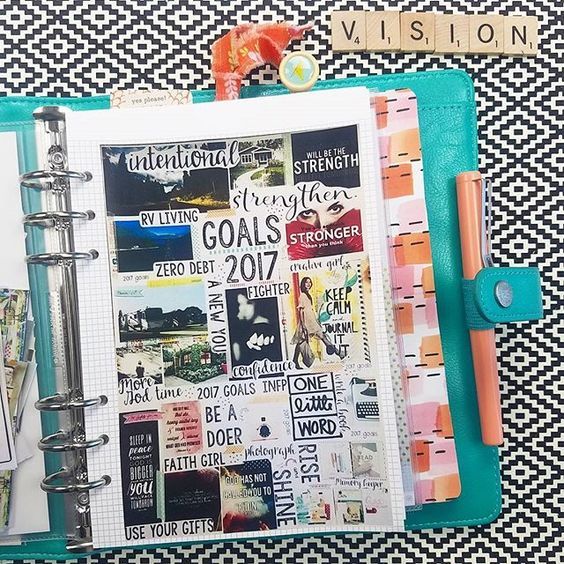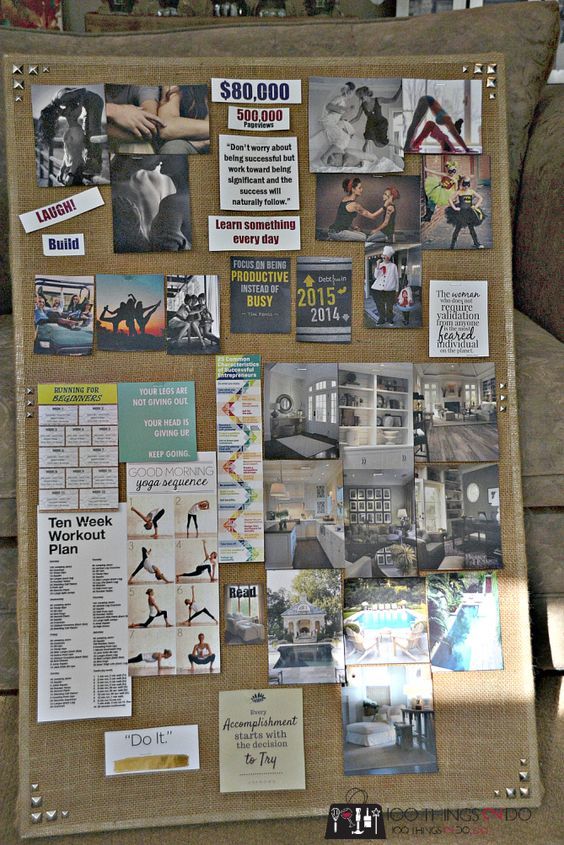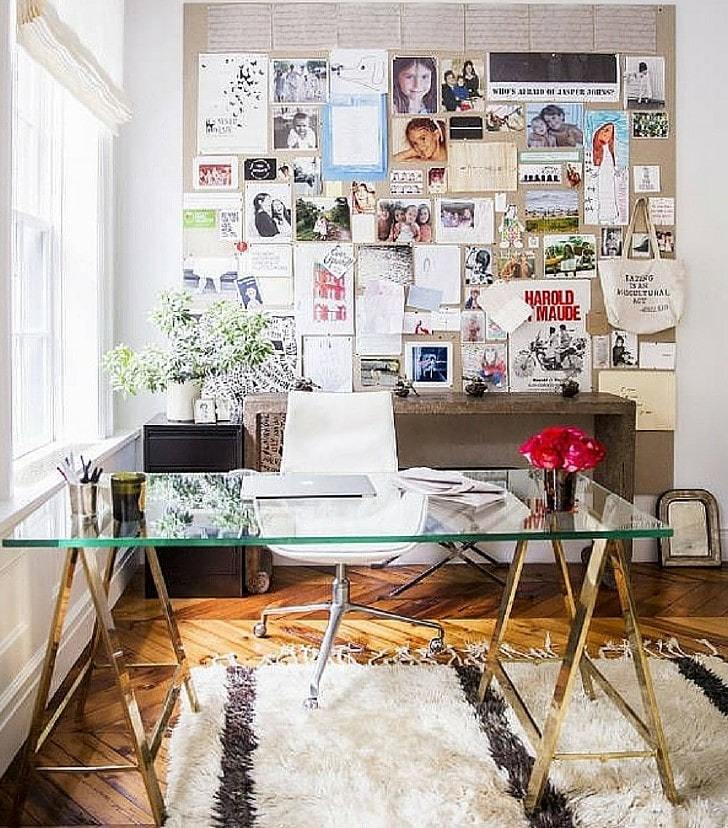Do you have a few goals that you really want to achieve?
One strategy that can make that happen is to make a vision board.
I’m sure you’ve heard of people creating vision boards to help motivate and inspire action toward meeting the desired outcome in their life. Some even hold vision board parties to make it a more social event.
When vision boards first became popular, I didn’t think it was something that was really up my alley; however, once I saw a close friend’s vision board, I figured I would give it a try.
While the result of my first vision board did serve as an effective constant reminder of my goals at the time, the process of creating it forced me to really think about what I want out of life and then take the extra step of recording it by including it on my vision board.
Remember– you’re 1.2 to 1.4 times more likely to achieve your goal if you commit to it in writing, so taking this minimal extra step is worth the trouble.
So, in this article, you will discover a simple five-step process to create your own vision board and use it to achieve the important goals in your life.
But first, let’s talk a bit more about what a vision board is and why it’s so important to have one whenever you’re working toward a life goal.
What Is a Vision Board (and Why Is It Important)?
A vision board (or mood board) is a self-made and powerful tool that you use to formulate, define, and maintain focus on a goal that you have for yourself. Your vision board will end up being unique to you and can be any type of board that you use to display text and images representing the things you want to be, accomplish, or have in your life.
You may be wondering,
“So why is it important to turn my goals into…an art project?”
Valid question. Simply put, the majority of us are extremely busy. We all have distractions–some welcomed and some not–and sometimes our goals get put on the backburner. But by creating and using a vision board, you’re:
If you’re someone who likes to create SMART goals, then you understand the need to have clarity when it comes to defining what you want in life. Your goals are supposed to be Specific, so you know where to focus your efforts and when the goal has been accomplished.
Example:
Not Specific: I want to be a leader.
Specific: I will complete a class on public speaking by May 15th, 2022, to improve my confidence when talking in front of a crowd. Following the class, I will use deliberate practice every day to continue to gain a necessary sense of confidence so I will be viewed as a leader and considered for a management position.
How to Make a Vision Board
When creating a vision board for a goal such as this, you would want to add pictures that will allow you to visualize your success.
This picture would be relevant for this type of vision board as it shows a confident person speaking to a captivated audience:
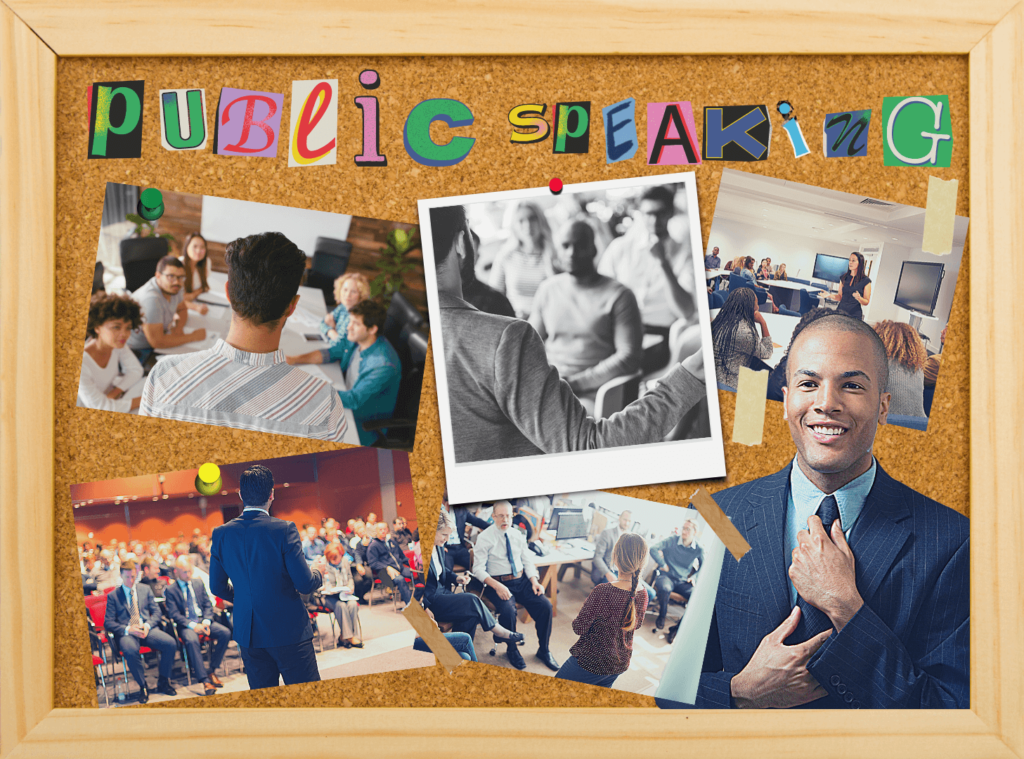
When you look at this picture on your vision board, you can visualize yourself being up front talking to that group of people with the same confidence the person in the picture seemingly has.
Keep in mind, the good thing about making your vision board is that you’re in control, and you can pick any pictures that speak to you and your goals.
Once you’ve created your vision board, you will end up with a visual representation that you can keep in front of you every day to remind you of your ‘why’ and what you’re working toward. This visual tool can be especially helpful on those challenging days that make you want to throw in the towel.
Because we are such visual beings, having this constant and concrete reminder of where you’re trying to go in life will help you maintain motivation and inspire you to take daily action to move closer to reaching your biggest and most important goals in life.
So now, let’s go through the process of making a vision board. Hopefully, following these steps will prevent you from making vision board mistakes that could hurt your goal-setting efforts.
Step #1: Collect Your Vision Board Supplies
There are a few things to keep in mind before you get started. First, remember that the purpose of your vision board is to give life to everything that’s on it. You want to feel an emotional connection with whatever image you include so that when you look at it, you will feel what you want for the future rather than merely seeing a 2D picture.
Secondly, it’s up to you if you want to create one big vision board for your whole life or break it down into several mini boards to cover the seven areas such as your relationships, profession, family, personal development, spirituality, social life, and health.
Another idea (because every area of your life is interlinked with the others) is to create one main vision board and then have some smaller “theme” boards for things like an upcoming vacation or a board that focuses on a major project at work.
Okay, to get started on a physical vision board, you will need up to eight types of supplies:
And if you want to get a detailed explanation behind the importance of each item, then read our article on the eight vision board supplies you might need.
Or, if you’re the digital vision board type, all you will need is one of these 11 online vision board apps or websites. Our favorite is the Canva Pro tool. (Check out this guide on how to create your vision board using Canva.)
Canva or Google images offers free photos you can use for your vision board online. You can even utilize a search function to find the best pictures to align with your goals. Once done, you can save your virtual vision board as the background on your computer, or you can print it out.
Finally, don’t worry about looking for the “perfect” vision board item. The most important thing here is just getting started and getting it done. This step doesn’t have to be difficult or tedious, and it also doesn’t have to cost a lot of money. You may already have several of the necessary supplies on hand.
Step #2: Identify Your Goal(s)
What do you want to focus on with this board?
If you’ve chosen to focus on one specific area of your life, write down some adjectives that describe how you want to feel when you look at the board.
If you’re unsure about what direction you want to go with your vision board, think about your values, skills, and interests, and ask yourself a few questions:
If you’re still stuck after answering these questions, then check out this list of 100 personal core values to focus on.
Start by setting goals based on the most important values to you, and then dig a bit deeper.For example, if you want to lose weight, how do you envision your life-changing once the weight is lost? Or, if you want to make a lot of money, what will you do with that money to improve your life?
Finally, once you’ve identified a few goals, put them into a SMART goal format. This video can show you how to do that (and it has 21 examples):
As you move closer to your vision, what adjustments need to be made?
Now that you have identified the goals you want to achieve, it is important to understand that these goals may change, and you may need to make adjustments as time goes on. If something changes, remember, your vision board isn't exactly set in stone. Feel free to edit things as needed.
You can cover up old pictures with new pictures, add new goals, and think about what you want to change. Your vision board reflects your positive emotions, feelings, dreams and is a visual representation of everything that inspires you. Have a dream or goal for several aspects of your life and think about the direction you want your life to take next.
Step #3: Prepare and Organize Your Vision Board
Set aside a reasonable amount of time (maybe two hours) to work on your vision board. But don’t rush it–doing so can defeat the purpose of creating a vision board altogether. After all, when we rush through life, we lose touch with what we reallywant. Do your best to ensure that this time is uninterrupted so you can focus on the task at hand.
Get started by preparing a folder (digital or physical) that holds a collection of pictures, quotes, affirmations, thoughts, photos, etc., representing your major goals or some element of your vision. Gather anything that represents the feelings or experiences you want to attract into your life.
One good strategy is to find free printables that can enhance the messaging of your goals. So check out this article that lists 31 free vision board printables.
Of course, you can go through magazines to look for pictures or even use some vision board printables, but it may be more effective to do some image searches on Google because you want your vision board to be very specific–you don’t want to settle for a picture from a magazine that’s close enough.
Here is a great video that can walk you through the Google image search process:
Pro Tip: You should end up with way more material than you will actually use, which is good because you can pick and choose a few concise options rather than having a crowded board that ends up becoming its own distraction. You can always save extra material for later use.
Be very selective about what you choose to put on your vision board.
Because your vision board should represent how you want your future self to feel, you don’t want to focus exclusively on stuff (e.g., pictures). Rather, you will want to add descriptive words, sayings, and quotes to your vision board that describes feelings. Some examples could be:
If you get stuck, here is an article with 45 printable quotes you can use on a vision board.
Another strategy is to add words such as these to your board by simply writing them or finding them in a magazine/on the internet and attaching them to the board. You can also add positive affirmations to help you get rid of that little voice inside your head that often feeds your limiting beliefs and makes you feel incapable of doing something.
Finally, you want to get a general idea of what you want the board to look like as you’re picking out pictures. You may want to stick with a certain color scheme or other design trends (or you may not), and you will want to be conscious of the size of the board that you’ve chosen.
Step #4: Create Your Layout
Once you’re all set with your materials, the next step is to lay everything out in a way that’s visually pleasing to you. As you’re creating structure, it might be a good idea to separate spaces on the board (just draw a line or circle) if you’re planning to do a “whole life” vision board that will feature a variety of aspects of your life.
Pro Tip #1: Make sure to write the specific goal in its assigned area if you do this, as this will help you stay organized as you’re making your layout. You can digitally separate the sections if you’re making a digital vision board.
Pro Tip #2: Designate the amount of space for each goal if you’re putting multiple goals on one board and be strategic about their placements. So, you may want to give your more important goals more space and put them front and center and move your relatively less important goals out to the side.
During this step, you will eliminate some pictures you had previously chosen, and you will likely look for additional pictures as your vision board starts coming together and your thoughts begin to expand.
Trim down your pictures and start layering your quotes and sayings over relevant images. Keep moving things around and trimming your images until it feels about right.
Pro Tip #3: Leave a bit of extra space to give yourself some additional room to work. Your vision board will expand. This will happen not only as you’re working on it but also once you think it’s complete. Make sure to take this into account before you cram too many things into one small area.
Here is an example of the process of creating a layout for your vision board.
More Ideas for Your Vision Board
Vision boarding is a great way to motivate you to follow through with your goal setting and start dreaming up more. Your vision board should contain things that inspire you and motivate you toward your ideal life, like financial goals, career goals, inspiring quotes, illustrations, positive affirmations, and purpose statements, just to name a few.
Also, if you’re stuck on what these vision boards should look like, then be sure to check out these two blog posts:
And if you’re looking for specific examples, here is a list of posts that focus on specific types of vision boards:
- 9 Real Estate Vision Board Ideas & Examples
- Vision Board Purpose: 7 Benefits of Using a Vision Board
- 11 Vision Board Ideas and Examples for Students
- 15 Vision Board Ideas for Kids to Visualize Their Goals
- 11 Vision Board Ideas and Examples for Teenagers
- 9 Vision Board Examples & Ideas for Teachers
- 11 Vision Board Ideas & Examples for Athletes
- 23 Vision Board Ideas for Men to Manifest Their Goals
- 11 Vision Board Ideas & Examples for Weight Loss
- 11 Vision Board Ideas for Couples to Improve Their Relationships
- 13 Vision Board Ideas & Examples for Your Dream Wedding
- 11 Vision Board Examples for Finding Love in Your Life
- 13 Vision Board Examples for Your Work or Job
- 7 Vision Board Examples & Ideas for Musicians
- 7 Vision Board Examples to Inspire Nursing Students
- 11 Vision Board Examples for Your Family to Share Together
- 9 Vision Board Examples for Your Addiction Recovery
- 13 Travel Vision Board Ideas & Examples
- 7 Vision Board Examples for Your Financial Freedom
Step #5: Finalize Your Vision Board
Once you’re happy with your vision board's look, attach all of your materials to your board. All you need to do now is determine where you want to hang your board so you’ll be able to see it multiple times a day.
As you can see from these examples, there is no limit to what your vision board should or could look like. You’ll notice some are small, and the images are laid out very close together like in this example:
Some are more abstract and casual, like this one:
And some are huge:
What your vision board ends up looking like in the end shouldn’t matter to anyone but you. This is your vision and your board. Lay out how you want your vision board to look before gluing things down.
Step #6: See and Believe Your Goals
Finally, have to go beyond identifying your goals. You need to really believe in yourself and claim your goals as things you will achieve because your thoughts create your reality.
Get into the mindset of expecting success to be inspired as you look at your completed vision board, and you will feel a sense of motivation to act on those feelings of inspiration moving forward.
We suggest that you look at and review your vision board at least two times a day — once in the morning and once in the evening.
If you feel stuck in this area, here is a great video on how to get rid of self-doubt and move forward with a sense of conviction.
One Main Vision Board or Many?
A big question people often ask is if they should make one big vision board that includes everything or make several for different areas of their life. There really is no right or wrong way to create your vision board. If it makes more sense for YOU to have more than one, then go for it!
Just don't get too overwhelmed by having too many boards. If you make more than one, perhaps you can have a career-oriented vision board you can hang at your office desk or frame to remind you of your career-focused goals.
Updating Your Vision Board
As we already mentioned, your vision board will likely change as you progress. Our recommendation is to leave some space on your vision board, so you have room to add things as you go. You can also create an entirely new board each year to better reflect your new goals and aspirations for the upcoming year.
If you have a big life change during the year, you may also consider redoing your board, especially if your goals no longer align and do not feel relevant anymore.
Do Vision Boards Work?
Yes! There is tons of research showing that vision boards really do work. Even Psychology Today has reported that athletes who used vision boards to visualize their training received just about the same benefits as those who physically undertook the exercises.
However, it is also important to remember that these visualization techniques will only work if you actually do the work to get there. Vision boarding can prove to be a powerful tool as long as you do the work.
Final Thoughts on How to Make a Vision Board
Once you have envisioned something, it’s time to start believing it and making it happen. Vision boards help you do this because they take your dreams and turn them into a tangible item. As you look at your vision board every day, you will notice that certain things remain prominent while others start to fall by the wayside.
You may start to realize that you don’t care about one thing as much as you once thought, but there is something that excites you every time you reflect on it.
For your vision board to be effective, you have to engage with it and allow it to guide your actions toward achieving your goals. Your vision board will act as a constant reminder of where you want to be, so as you’re in the process of creating it, be intentional about what you choose to put on there.
Now, if you want to take this concept to the next level, one way to do that is to host a vision board party, which we show you how to do in this article.
